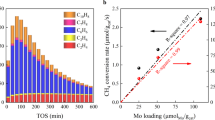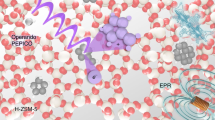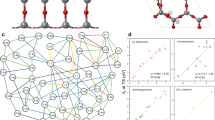Abstract
Unravelling the pathways of catalytic methane functionalization sets the foundations for the efficient production of valuable chemicals and fuels from this abundant feedstock. The catalytic oxybromination of methane into platform compounds bromomethane and dibromomethane constitutes a prominent example, although it displays a puzzling reaction network that has been speculated to involve free-radical intermediates. Here, photoelectron photoion coincidence spectroscopy with synchrotron radiation was used to provide evidence of the evolution of gaseous methyl and bromine radicals over (VO)2P2O7 and EuOBr catalysts and the strong correlation between the formation of methyl radicals and the production of bromomethanes. Complemented by kinetic data on methane oxybromination and non-catalytic methane bromination, these results imply the surface-catalysed generation of bromine radicals and molecular bromine followed by the gas-phase methane bromination, which is rationalized by density functional theory calculations. The findings emphasize the role of both surface and gas-phase steps in halogen-mediated C–H bond activation over heterogeneous catalysts.
This is a preview of subscription content, access via your institution
Access options
Access Nature and 54 other Nature Portfolio journals
Get Nature+, our best-value online-access subscription
$29.99 / 30 days
cancel any time
Subscribe to this journal
Receive 12 digital issues and online access to articles
$119.00 per year
only $9.92 per issue
Buy this article
- Purchase on Springer Link
- Instant access to full article PDF
Prices may be subject to local taxes which are calculated during checkout




Similar content being viewed by others
References
Ito, T. & Lunsford, J. H. Synthesis of ethylene and ethane by partial oxidation of methane over lithium-doped magnesium oxide. Nature 314, 721–722 (1985).
Bodke, A. S., Olschki, D. A., Schmidt, L. D. & Ranzi, E. High selectivities to ethylene by partial oxidation of ethane. Science 285, 712–715 (1999).
Guo, X. et al. Direct, nonoxidative conversion of methane to ethylene, aromatics, and hydrogen. Science 344, 616–619 (2014).
Gärtner, C. A., van Veen, A. C. & Lercher, J. A. Oxidative dehydrogenation of ethane: common principles and mechanistic aspects. ChemCatChem 5, 3196–3217 (2013).
Sattler, J. J. H. B., Ruiz-Martinez, J., Santillan-Jimenez, E. & Weckhuysen, B. M. Catalytic dehydrogenation of light alkanes on metals and metal oxides. Chem. Rev. 114, 10613–10653 (2014).
Kwapien, K. et al. Sites for methane activation on lithium-doped magnesium oxide surfaces. Angew. Chem. Int. Ed. 53, 8774–8778 (2014).
Grundner, S. et al. Single-site trinuclear copper oxygen clusters in mordenite for selective conversion of methane to methanol. Nat. Commun. 6, 7546 (2015).
Tomkins, P. et al. Isothermal cyclic conversion of methane into methanol over copper-exchanged zeolite at low temperature. Angew. Chem. Int. Ed. 55, 5467–5471 (2016).
Latimer, A. A. et al. Understanding trends in C-H bond activation in heterogeneous catalysis. Nat. Mater. 16, 225–229 (2016).
Gerceker, D. et al. Methane conversion to ethylene and aromatics on PtSn catalysts. ACS Catal. 7, 2088–2100 (2017).
Driscoll, D. J., Martir, W., Wang, J. & Lunsford, J. H. Formation of gas-phase methyl radicals over MgO. J. Am. Chem. Soc. 107, 58–63 (1985).
Luo, L. et al. Methyl radicals in oxidative coupling of methane directly confirmed by synchrotron VUV photoionization mass spectroscopy. Sci. Rep. 3, 1625 (2013).
Hargreaves, J., Hutchings, G. & Joyner, R. Control of product selectivity in the partial oxidation of methane. Nature 348, 428–429 (1990).
Horn, R. et al. Gas phase contributions to the catalytic formation of HCN from CH4 and NH3 over Pt: an in situ study by molecular beam mass spectrometry with threshold ionization. Phys. Chem. Chem. Phys. 6, 4514–4521 (2004).
He, J. et al. Transformation of methane to propylene: a two-step reaction route catalyzed by modified CeO2 nanocrystals and zeolites. Angew. Chem. Int. Ed. 51, 2438–2442 (2012).
Paunović, V., Zichittella, G., Moser, M., Amrute, A. P. & Pérez-Ramírez, J. Catalyst design for natural-gas upgrading through oxybromination chemistry. Nat. Chem. 8, 803–809 (2016).
Paunović, V. et al. Europium oxybromide catalysts for efficient bromine looping in natural gas valorization. Angew. Chem. Int. Ed. 56, 9791–9795 (2017).
Ding, K. et al. Hydrodebromination and oligomerization of dibromomethane. ACS Catal. 2, 479–486 (2012).
Lin, R., Amrute, A. P. & Pérez-Ramírez, J. Halogen-mediated conversion of hydrocarbons to commodities. Chem. Rev. 117, 4182–4247 (2017).
Zichittella, G., Paunović, V., Amrute, A. P. & Pérez-Ramírez, J. Catalytic oxychlorination versus oxybromination for methane functionalization. ACS Catal. 7, 1805–1817 (2017).
Kistiakowsky, G. B. & Van Artsdalen, E. R. Bromination of hydrocarbons. I. Photochemical and thermal bromination of methane and methyl bromine. Carbon-hydrogen bond strength in methane. J. Chem. Phys. 12, 469–478 (1944).
Lorkovic, I. M. et al. Alkane bromination revisited: “reproportionation” in gas-phase methane bromination leads to higher selectivity for CH3Br at moderate temperatures. J. Phys. Chem. A 110, 8695–8700 (2006).
Ding, K., Metiu, H. & Stucky, G. D. The selective high-yield conversion of methane using iodine-catalyzed methane bromination. ACS Catal. 3, 474–477 (2013).
Li, B. & Metiu, H. Does halogen adsorption activate the oxygen atom on an oxide surface? I. A study of Br2 and HBr adsorption on La2O3 and La2O3 doped with Mg or Zr. J. Phys. Chem. C. 116, 4137–4148 (2012).
Martir, W. & Lunsford, J. H. The formation of gas-phase π-allyl radicals from propylene over bismuth oxide and γ-bismuth molybdate catalysts. J. Am. Chem. Soc. 103, 3728–3732 (1981).
Qi, F. Recent applications of synchrotron VUV photoionization mass spectrometry in combustion and energy research. Acc. Chem. Res. 10, 68–78 (2010).
Li, Y. et al. Effect of the pressure on the catalytic oxidation of volatile organic compounds over Ag/Al2O3 catalyst. Appl. Catal. B 89, 659–664 (2009).
Jiao, F. et al. Selective conversion of syngas to light olefins. Science 351, 1065–1068 (2016).
Osborn, D. L. et al. Breaking through the false coincidence barrier in electron-ion coincidence experiments. J. Chem. Phys. 145, 164202 (2016).
Tang, X., Garcia, G. A. & Nahon, L. CH3 + formation in the dissociation of energy-selected CH3F+ studied by double imaging electron/ion coincidences. J. Phys. Chem. A 119, 5942–5950 (2015).
Sztáray, B. et al. CRF-PEPICO: double velocity map imaging photoelectron photoion coincidence spectroscopy for reaction kinetics studies. J. Chem. Phys. 147, 13944 (2017).
Oßwald, P. et al. In situ flame chemistry tracing by imaging photoelectron photoion coincidence spectroscopy. Rev. Sci. Instrum. 85, 025101 (2014).
Hemberger, P., Custodis, V. B. F., Bodi, A., Gerber, T. & van Bokhoven, J. A. Understanding the mechanism of catalytic fast pyrolysis by unveiling reactive intermediates in heterogeneous catalysis. Nat. Commun. 8, 15946 (2017).
Eränen, K., Lindfors, L. E., Klingstedt, F. & Murzin, D. Y. Continuous reduction of NO with octane over a silver/alumina catalyst in oxygen-rich exhaust gases: combined heterogeneous and surface-mediated homogeneous reactions. J. Catal. 219, 25–40 (2003).
Hemberger, P., Trevitt, A. J., Gerber, T., Ross, E. & Da Silva, G. Isomer-specific product detection of gas-phase xylyl radical rearrangement and decomposition using VUV synchrotron photoionization. J. Phys. Chem. A 118, 3593–3604 (2014).
Lias, S. G. et al. in NIST Chemistry WebBook: NIST Standard Reference Database (National Institute of Standards and Technology, 2008).
Traeger, J. C. & McLoughlin, R. G. Absolute heats of formation for gas-phase cations. J. Am. Chem. Soc. 103, 3647–3652 (1981).
Chang, Y.-C., Xiong, B., Bross, D. H., Ruscic, B. & Ng, C. Y. A vacuum ultraviolet laser pulsed field ionization-photoion study of methane (CH4): determination of the appearance energy of methylium from methane with unprecedented precision and the resulting impact on the bond dissociation energies of CH4 and CH4 +. Phys. Chem. Chem. Phys. 19, 9592–9605 (2017).
Kaposi, O., Riedel, M., Vass-Balthazar, K., Sanchez, G. R. & Lelik, L. Mass-spectrometric determination of thermochemical data of CHBr3 and CBr4 by study of their electron impact and heterogeneous pyrolytic decompositions. Acta Chim. Acad. Sci. Hung. 89, 221 (1976).
DeCorpo, J. J., Bafus, D. A. & Franklin, J. L. Enthalpies of formation of the monohalomethyl radicals from mass spectrometric studies of the dihalomethanes. J. Chem. Thermodyn. 3, 125–127 (1971).
Guan, Q. et al. The properties of a micro-reactor for the study of the unimolecular decomposition of large molecules. Int. Rev. Phys. Chem. 33, 447–487 (2014).
Person, J. C. & Nicole, P. P. Isotope effects in the photoionization yields and in the absorption cross sections for methanol, ethanol, methyl bromide, and ethyl bromide. J. Chem. Phys. 55, 3390–3397 (1971).
Gans, B. et al. Determination of the absolute photoionization cross sections of CH3 and I produced from a pyrolysis source, by combined synchrotron and vacuum ultraviolet laser studies. J. Phys. Chem. A 114, 3237–3246 (2010).
Bodi, A., Sztáray, B., Baer, T., Johnson, M. & Gerber, T. Data acquisition schemes for continuous two-particle time-of-flight coincidence experiments. Rev. Sci. Instrum. 78, 084102 (2007).
Bodi, A. et al. Imaging photoelectron photoion coincidence spectroscopy with velocity focusing electron optics. Rev. Sci. Instrum. 80, 034101 (2009).
Sztáray, B. & Baer, T. Suppression of hot electrons in threshold photoelectron photoion coincidence spectroscopy using velocity focusing optics. Rev. Sci. Instrum. 74, 3763–3768 (2003).
Kresse, G. & Furthmüller, J. Efficiency of ab-initio total energy calculations for metals and semiconductors using a plane-wave basis set. Comput. Mater. Sci. 6, 15–50 (1996).
Kresse, G. & Furthmüller, J. Efficient iterative schemes for ab initio total-energy calculations using a plane-wave basis set. Phys. Rev. B 54, 11169–11186 (1996).
Perdew, J. P., Burke, K. & Ernzerhof, M. Generalized gradient approximation made simple. Phys. Rev. Lett. 77, 3865–3868 (1996).
Blöchl, P. E. Projector augmented-wave method. Phys. Rev. B 50, 17953–17979 (1994).
Mayer, I., Zolotov, S. & Kassierer, F. The crystal structure of rare earth and yttrium oxybromides. Inorg. Chem. 4, 1637–1639 (1965).
Henkelman, G., Uberuaga, B. P. & Jónsson, H. Climbing image nudged elastic band method for finding saddle points and minimum energy paths. J. Chem. Phys. 113, 9901–9904 (2000).
Álvarez-Moreno, M., de Graaf, C., López, N., Maseras, F., Poblet, J. M. & Bo, C. Managing the computational chemistry big data problem: the ioChem-BD platform. J. Chem. Inf. Model. 55, 95–103 (2015).
López, N. Computational Dataset for 'Evidence of Radical Chemistry in Catalytic Methane Oxybromination' (ioChem, 2018); https://doi.org/10.19061/iochem-bd-1-71.
Acknowledgements
This work was supported by the Swiss National Science Foundation (project no. 200021-156107) and the Swiss Federal Office of Energy (contract no. SI/501269-01). D. Teschner from the Fritz Haber Institute of the Max Planck Society, Berlin; L. Szentmiklósi from the Centre for Energy Research, Hungarian Academy of Sciences, Budapest; and M. Moser are acknowledged for their help in performing prompt gamma activation analysis.
Author information
Authors and Affiliations
Contributions
J.P.-R. conceived and coordinated all stages of this research. V.P. prepared and characterized the catalysts, and performed and analysed the steady-state tests. V.P., P.H. and A.B. conducted operando PEPICO spectroscopy experiments. P.H. and A.B. analysed the results of PEPICO spectroscopy. N.L. conducted the DFT calculations. The data were discussed among all the authors. V.P., P.H. and J.P.-R. wrote the paper with feedback from the other authors.
Corresponding author
Ethics declarations
Competing interests
The authors declare that they have no competing interests.
Additional information
Publisher’s note: Springer Nature remains neutral with regard to jurisdictional claims in published maps and institutional affiliations.
Supplementary information
Supplementary Information
Supplementary Tables 1 & 2; Supplementary Figures 1–10; Supplementary References
Rights and permissions
About this article
Cite this article
Paunović, V., Hemberger, P., Bodi, A. et al. Evidence of radical chemistry in catalytic methane oxybromination. Nat Catal 1, 363–370 (2018). https://doi.org/10.1038/s41929-018-0071-z
Received:
Accepted:
Published:
Issue Date:
DOI: https://doi.org/10.1038/s41929-018-0071-z
This article is cited by
-
Tuning the zeolite acidity enables selectivity control by suppressing ketene formation in lignin catalytic pyrolysis
Nature Communications (2023)
-
Methyl radical chemistry in non-oxidative methane activation over metal single sites
Nature Communications (2023)
-
Facile construction of non-crystalline ZrO2 as an active yet durable catalyst for methane oxychlorination
Journal of Sol-Gel Science and Technology (2019)



